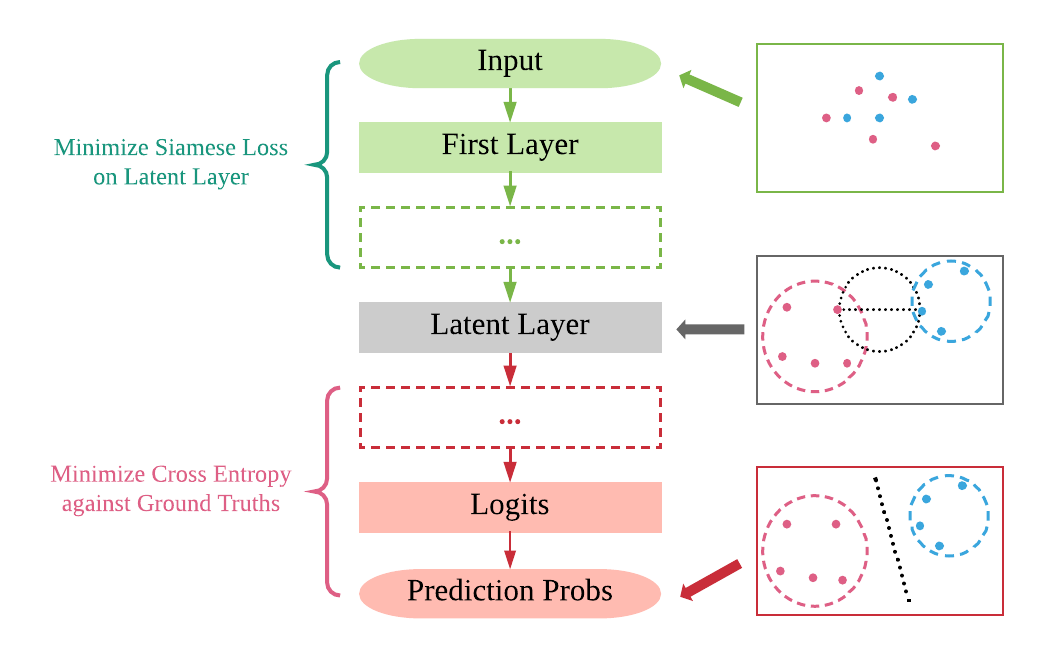Partial Siamese Training - An Example With AlexNet
This project aims to partially employ another optimization technique rather than pure gradient based method. The techinque is referred to as Optimization Objective Breakdown, as it breaks down optimization into two (or more) parts.
How to Improve upon Gradient-Based Methods
Illustration of the Proposed Method
Gradient-Based Methods
Traditional methods of tuning a neural network relies heavily (and often solely) on gradients w.r.t. loss function
Optmization Object Breakdown
With Optimization Objective Breakdown, we improve upon the gradient model by splitting the network into two parts, separated by a latent layer. We define a pair-wise loss function on representations in the latent layer--our choice is the Siamese Loss.
- All layers prior to the latent layer is trained with the objective of minimizing Siamese Loss on the latent layer.
- In this phase, training model does not require prediction information. The latter part of the model is not used.
- All layers pursuant to the latent layer is trained with the objective of minimizing cross-entropy on the prediction layer.
- In this phase, only the second part of the model is trained. (The first part of the model is fixed).
Mathematical Intuition
In our paper, Classification of Citrus Canker on Small Datasets, we mathematically proved that this techinique can result in linear separability of representations on the latent layer, if the model is sufficiently trained. This intuition entails that the second part of the model only needs to draw a hyperplane for classification, a trivial task for any neural networks.
Version Info
The code is refactored for compatibility with latest version of Tensorflow. You can find an explanation of the new input pipeline in a new blog post You can use this code as before for finetuning AlexNet on your own dataset without OpenCV.
This repository contains all the code needed to finetune AlexNet on any arbitrary dataset. Beside the comments in the code itself, I also wrote an article which you can fine here with further explanation.
All you need are the pretrained weights, which you can find here or convert yourself from the caffe library using caffe-to-tensorflow.
If you convert them on your own, take a look on the structure of the .npy weights file (dict of dicts or dict of lists).
Note: I won't write to much of an explanation here, as I already wrote a long article about the entire code on my blog.
Requirements
- Python 3
- TensorFlow >= 1.12rc0
- Numpy
TensorBoard support
The code has TensorFlows summaries implemented so that you can follow the training progress in TensorBoard. (--logdir in the config section of finetune.py)
Content
alexnet.py: Class with the graph definition of the AlexNet.finetune.py: Script to run the finetuning process.datagenerator.py: Contains a wrapper class for the new input pipeline.caffe_classes.py: List of the 1000 class names of ImageNet (copied from here).validate_alexnet_on_imagenet.ipynb: Notebook to test the correct implementation of AlexNet and the pretrained weights on some images from the ImageNet database.images/*: contains three example images, needed for the notebook.
Usage
All you need to touch is the finetune.py, although I strongly recommend to take a look at the entire code of this repository. In the finetune.py script you will find a section of configuration settings you have to adapt on your problem.
If you do not want to touch the code any further than necessary you have to provide two .txt files to the script (train.txt and val.txt). Each of them list the complete path to your train/val images together with the class number in the following structure.
Example train.txt:
/path/to/train/image1.png 0
/path/to/train/image2.png 1
/path/to/train/image3.png 2
/path/to/train/image4.png 0
.
.
were the first column is the path and the second the class label.
The other option is that you bring your own method of loading images and providing batches of images and labels, but then you have to adapt the code on a few lines.
